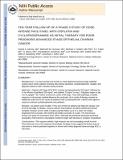| dc.contributor.author | Sarosy, Gisele A. | |
| dc.contributor.author | Hussain, Mahrukh M. | |
| dc.contributor.author | Seiden, Michael V. | |
| dc.contributor.author | Fuller, A.F. | |
| dc.contributor.author | Nikrui, Najmosama | |
| dc.contributor.author | Goodman, Annekathryn | |
| dc.contributor.author | Minasian, Lori M. | |
| dc.contributor.author | Reed, Eddie | |
| dc.contributor.author | Steinberg, Seth M. | |
| dc.contributor.author | Kohn, Elise C. | |
| dc.date.accessioned | 2019-07-08T16:14:32Z | |
| dc.date.issued | 2010-03-15 | |
| dc.identifier.citation | Sarosy, Gisele A., Mahrukh M. Hussain, Michael V. Seiden, Arlan F. Fuller, Najmosama Nikrui, Annekathryn Goodman, Lori Minasian, Eddie Reed, Seth M. Steinberg, and Elise C. Kohn. "Ten‐year Follow‐up of a Phase 2 Study of Dose‐intense Paclitaxel with Cisplatin and Cyclophosphamide as Initial Therapy for Poor‐prognosis, Advanced‐stage Epithelial Ovarian Cancer." Cancer 116, no. 6 (2010): 1476-484. | en_US |
| dc.identifier.issn | 0008-543X | en_US |
| dc.identifier.issn | 1097-0142 | en_US |
| dc.identifier.uri | http://nrs.harvard.edu/urn-3:HUL.InstRepos:40839003 | * |
| dc.description.abstract | Background
To assess activity and toxicity in newly diagnosed advanced stage epithelial ovarian cancer (EOC) patients receiving dose-intense paclitaxel, cyclophosphamide, cisplatin, and filgrastim delivered with a flexible dosing schedule.
Methods
Patients with Stage III/IV EOC received cyclophosphamide 750 mg/m2, followed by 24 hr infusion of paclitaxel 250 mg/m2, and cisplatin 75 mg/m2 on day 2. Filgrastim began on day 3 at 10 μg/kg/d × 9d. Patients received six cycles of all drugs. Those with pathologic complete response or microscopic residual disease at the conclusion of six cycles of therapy received an additional cycles two to four cycles of paclitaxel with cyclophosphamide. Patients with objective response continued cyclophosphamide and paclitaxel.
Results
62 patients were enrolled. Thirty-two of these 62 patients had stage IIIC disease, and 26 of 62 had stage IV disease. Using an intent to treat analysis, 55 (89%) experienced clinical complete remission (CCR). With a median potential follow-up of 11.4 years, the median progression free survival is 18.9 months and median survival is 5.4 years. The most serious toxicity was grade 3/4 neutropenic fever (35%). Although all participants developed peripheral neuropathy, improvement in neuropathic symptoms began with decrease or cessation of paclitaxel.
Conclusions
This regimen yielded a high response rate and encouraging overall survival. These data and those of the Japanese Gynecologic Oncology Group suggest that further study of dose dense or intense paclitaxel regimens in women with newly diagnosed advanced stage EOC is warranted. | en_US |
| dc.language.iso | en_US | en_US |
| dc.publisher | Wiley | en_US |
| dash.license | LAA | |
| dc.subject | Cancer Research | en_US |
| dc.subject | Oncology | en_US |
| dc.subject | ovarian neoplasms | en_US |
| dc.subject | paclitaxel | en_US |
| dc.subject | cyclophosphamide | en_US |
| dc.subject | cisplatin | en_US |
| dc.subject | antineoplastic combined chemotherapy protocols | en_US |
| dc.subject | filgrastim | en_US |
| dc.subject | drug dose-response relationship | en_US |
| dc.title | Ten-Year Follow-Up of a Phase 2 Study of Dose-Intense Paclitaxel With Cisplatin and Cyclophosphamide as Initial Therapy for Poor-Prognosis, Advanced-Stage Epithelial Ovarian Cancer | en_US |
| dc.type | Journal Article | en_US |
| dc.description.version | Accepted Manuscript | en_US |
| dc.relation.journal | Cancer | en_US |
| dash.depositing.author | Nikrui, Najmosama | |
| dc.date.available | 2019-07-08T16:14:32Z | |
| dash.affiliation.other | Harvard Medical School | en_US |
| dc.identifier.doi | 10.1002/cncr.24861 | |
| dc.source.journal | Cancer | |
| dash.source.volume | 116;6 | |
| dash.source.page | 1476-1484 | |
| dash.contributor.affiliated | Nikrui, Najmosama | |
| dash.contributor.affiliated | Goodman, Annekathryn | |


